Large Scale trains need maintenance from time to time, no matter who manufactured them. One of the most basic needs is lubrication. Most rolling stock can be lubricated by just turning it over and oiling the axles. Locomotives usually need to be partially disassembled to get to the points that need lubrication, and this takes some basic tools. Other needs for these simple tools are for repair or replacement of parts that wear out or become damaged through some form of accident. Many of the tools necessary for this basic work are also handy around the house and you probably already have some of them already.
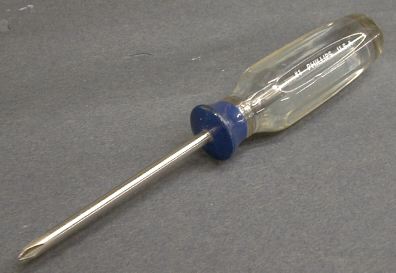 The single
most important basic tool is a #1 Phillips head (sometimes called
cross point) screwdriver. Virtually all Large Scale equipment is
assembled with cross point screws and 99% of those can be removed
or replaced with a #1 screwdriver. Buy the best one that you can
find. The Craftsman brand (available at Sears) is a good tool and
is widely available. Even the Craftsman brand comes in several
grades, spend the money and get the best quality offered.
The single
most important basic tool is a #1 Phillips head (sometimes called
cross point) screwdriver. Virtually all Large Scale equipment is
assembled with cross point screws and 99% of those can be removed
or replaced with a #1 screwdriver. Buy the best one that you can
find. The Craftsman brand (available at Sears) is a good tool and
is widely available. Even the Craftsman brand comes in several
grades, spend the money and get the best quality offered.
Actually, this admonishment applies to ALL tools. Cheap tools are cheap because they are made of lesser quality materials with lesser precision. Cheap tools usually end up doing far more damage than their cost savings was worth. If there is a professional tool supply outlet near you, check it out. In the long run, you will be glad that you did.
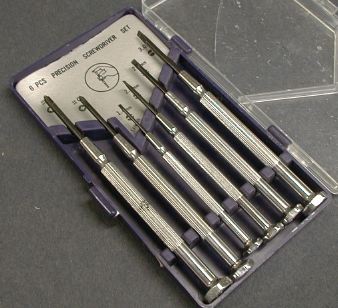 For
model railroad work, you won't often need a screwdriver bigger than
a #1 Phillips, but you will need smaller ones. One way to get them
is to buy a Jeweler's screwdriver set. These come with some number
of small Phillips and straight blade screwdrivers with small
handles. The slim construction is often nice as clearance for the
screwdriver handle is often not available.
For
model railroad work, you won't often need a screwdriver bigger than
a #1 Phillips, but you will need smaller ones. One way to get them
is to buy a Jeweler's screwdriver set. These come with some number
of small Phillips and straight blade screwdrivers with small
handles. The slim construction is often nice as clearance for the
screwdriver handle is often not available.
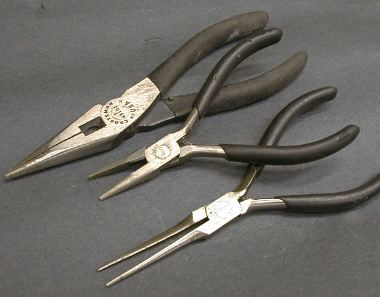 A pair of needle
nose pliers is probably the next most important tool. For our work,
a small pair with a fine tip is preferred. There are many kinds
with tips of various geometries, the ones shown are probably the
most useful, but you may eventually collect several other kinds.
The tool will be needed to hold small parts without crushing them
and to maneuver them into tight spots. Look at every pair on
display in the store and pick the one with tips that are flush and
fit tightly together. Hold the tool up to the light, you shouldn't
be able to see any light coming between the jaws. Spring loading of
the jaws is sometimes helpful but not completely necessary.
A pair of needle
nose pliers is probably the next most important tool. For our work,
a small pair with a fine tip is preferred. There are many kinds
with tips of various geometries, the ones shown are probably the
most useful, but you may eventually collect several other kinds.
The tool will be needed to hold small parts without crushing them
and to maneuver them into tight spots. Look at every pair on
display in the store and pick the one with tips that are flush and
fit tightly together. Hold the tool up to the light, you shouldn't
be able to see any light coming between the jaws. Spring loading of
the jaws is sometimes helpful but not completely necessary.
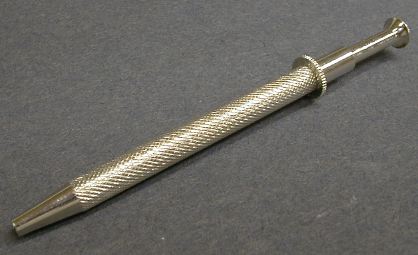 Another tool
that is handier than a shirt pocket is the Kadee 5 Finger Grabber
tool. This little gem is designed to pick up and hold small parts
such as screws so that they can be inserted into and removed from
tight places. You'll find these in hobby shops that carry other
Kadee products.
Another tool
that is handier than a shirt pocket is the Kadee 5 Finger Grabber
tool. This little gem is designed to pick up and hold small parts
such as screws so that they can be inserted into and removed from
tight places. You'll find these in hobby shops that carry other
Kadee products.
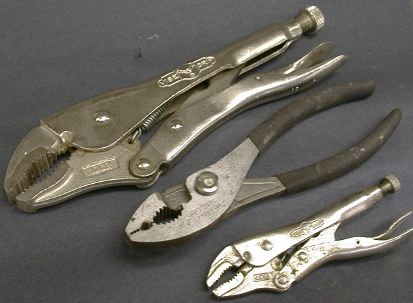 Larger and stronger tools are handy in some
instances. A regular pair of gas pliers (center) is almost
essential. This tool can be used to grab and hold larger objects.
They can also be used to bend or break parts or materials as
necessary. They are really good at squeezing and tightening rail
joiners that have become too loose. A similar large heavy tool is
the Vice Grip (left). These come in various sizes with various jaw
geometries, the smaller ones (right) being the most useful to
modelers. The Vice Grip is a latching tool that can be used to
squeeze and hold objects.
Larger and stronger tools are handy in some
instances. A regular pair of gas pliers (center) is almost
essential. This tool can be used to grab and hold larger objects.
They can also be used to bend or break parts or materials as
necessary. They are really good at squeezing and tightening rail
joiners that have become too loose. A similar large heavy tool is
the Vice Grip (left). These come in various sizes with various jaw
geometries, the smaller ones (right) being the most useful to
modelers. The Vice Grip is a latching tool that can be used to
squeeze and hold objects.
© 1999 George Schreyer
Created Dec 4, 1999
Last Updated Dec 4, 1999